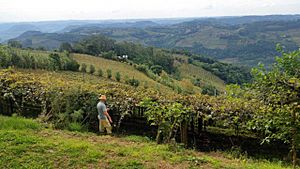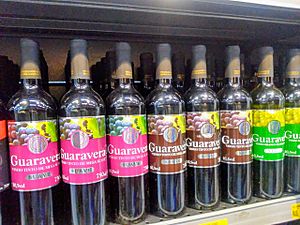Brazilian wine facts for kids

Brazil is a big country in South America, and it's also a significant producer of wine! It ranks third in South America for wine production, right after Argentina and Chile. In 2019, Brazil was the 15th largest wine producer in the whole world.
A large area of land in Brazil is used for growing grapes, about 82,000 hectares (that's like 200,000 acres!). However, not all these grapes are used to make wine. Many are grown as table grapes, which are the kind you eat fresh.
The best quality wines in Brazil, called vinho fino in Portuguese, are made from a special type of European grape called Vitis vinifera. But most of the grapes grown in Brazil are American or mixed types. These are often easier to grow in Brazil's climate.
Where is Brazilian Wine Made?

Brazil is a huge country, and its weather changes a lot from one place to another. Even though grapes are usually grown in cooler places, Brazil has found ways to make wine in both hot and mild climates.
Most of Brazil's wine comes from the cooler southern part of the country. This area is mainly in the state of Rio Grande do Sul. Here, many grape farms are located on higher ground, which helps keep them cool. This region is known as the Serra Gaúcha, or "Gaucho Highlands." You can also find some smaller grape farms in the nearby state of Santa Catarina.
Interestingly, some wine is also made in a very different place: the São Francisco Valley in Pernambuco. This area has a hot, dry climate. What's special about it is that farmers can grow two crops of grapes there every single year!
A Short History of Brazilian Wine
People have tried to grow European grapes in Brazil for hundreds of years. The first grapevines were brought by the Portuguese in 1532 to the state of São Paulo. Later, in 1626, a group called the Jesuits brought Spanish grapevines to Rio Grande do Sul.
In 1840, a type of grape called Isabella (which is an American grape) was successfully planted on the southern coast of Rio Grande. This was a big step for grape growing in Brazil. By the late 1870s, making wine became more common, especially in the Serra Gaúcha region. Many Italian immigrants helped grow the grapes there, mostly using American types. Later, some Italian grape types and a grape called Tannat were also added.

The quality of Brazilian wine started to improve a lot in the 1970s. This was when big international wine companies, like Moet & Chandon, invested in Brazil. They brought new knowledge and modern equipment, which helped Brazil make better wines.

